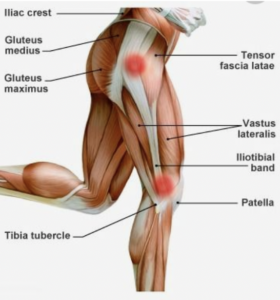One of the most common reasons clients come to our studio is to find relief from lower back pain. We see this in clients who sit at desks all day, as well as clients who are very active either training for a race or maintaining a rigorous workout schedule. The origin of this pain often stems from the IT Band and the glutes. The IT Band, also known as the iliotibial band, runs lateral to the quads (the outside of the thigh). This band runs from the iliac crest, which is part of the pelvic-hip complex (as shown below) and around the outside of the knee. The knee is the most common place people think of when they hear the words “tight IT Band” – but the low back is just as common an area to be affected.
If you take a look at the study of movement, muscles work in conjunction in order to facilitate movement by pulling on the bone; everything within the body is somehow connected. Therefore, anything that is misaligned or tight may cause an improper movement pattern somewhere else in the body, altering proper function.
 If there is tension in the IT Band or gluteus, they begin to pull on adjacent muscles within the complex of the hips, notably the Quadratus Lumborum (QL’s). The QL muscle is technically an abdominal muscle but it has tremendous impact on the lumbar region of your lower back.
If there is tension in the IT Band or gluteus, they begin to pull on adjacent muscles within the complex of the hips, notably the Quadratus Lumborum (QL’s). The QL muscle is technically an abdominal muscle but it has tremendous impact on the lumbar region of your lower back.
The IT band provides stability at the hip during lateral movements. Other muscles that stabilize the hip includes the gluteus medius and the quadratus lumborum (QL). As the IT Band tightens due to injury or overuse, friction will cause a downwards pull of the gluteus medius and the QL, causing the upper body to laterally bend a few degrees to the right. Even a slight pull on the lumbar spine could potentially compress the nerves and lead to pain and even greater neuromuscular problems later in life.
How do we approach this in the studio? We begin with an assessment by performing various stretches on the client. First, we test the hip flexors and the muscles of the quads to determine whether these muscles contribute to the lower back pain. From this point on, we turn to the IT Band and test its range of motion. Often times the IT Band contributes to tightness in the gluteus medius. Tightness in this muscle creates tension within the rest of the gluteus muscles. After stretching the gluteus muscles, we make sure to check in with the client to see how they are feeling after the series of stretches. The last piece within this series is to target the Quadratus Lumborum. Since the QL has several attachments into the spine, we make sure to perform a light and smooth stretch in order to allow the client to relax on the table and prevent the nervous system from protecting the muscle. Once the nervous system has relaxed, we see incredible results from the stretch,relieving a great amount of tension within our client’s lower back. We then re-asses by testing the range of motion of the IT Band and see how the client feels when they get off the table. As they start walking around the studio, they experience notable relief in their lower back and improvement in their gait.
Lower back pain affects so many people – yet every body is different. Treating the whole body is key to finding the source of the pain and finding the path to relief and recovery.
Not local to one of our studios?



